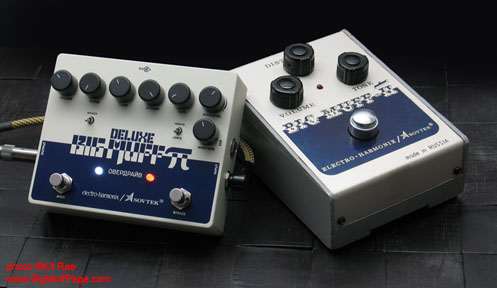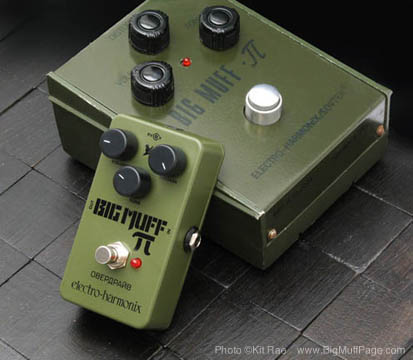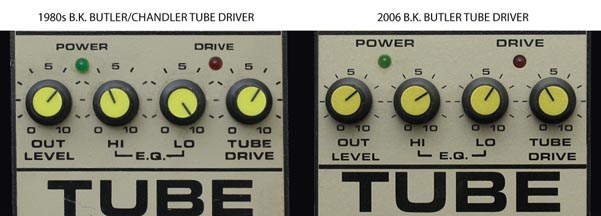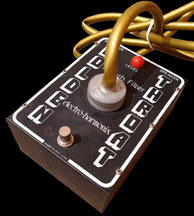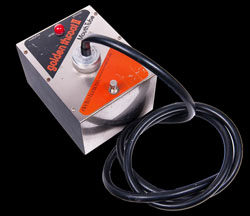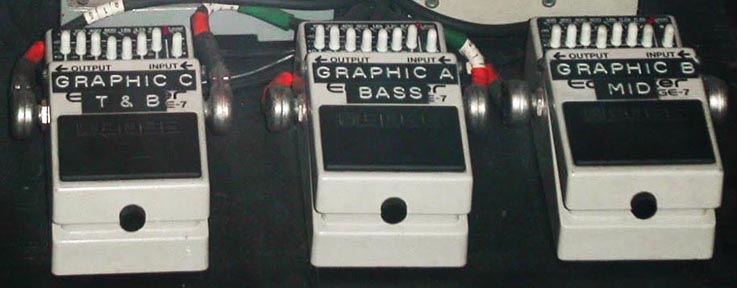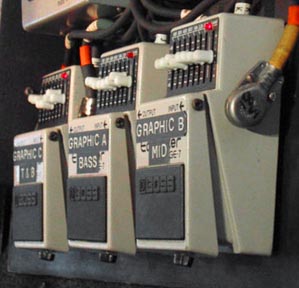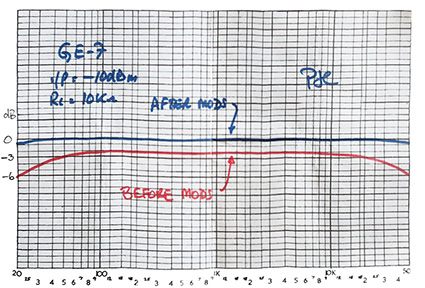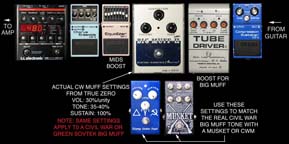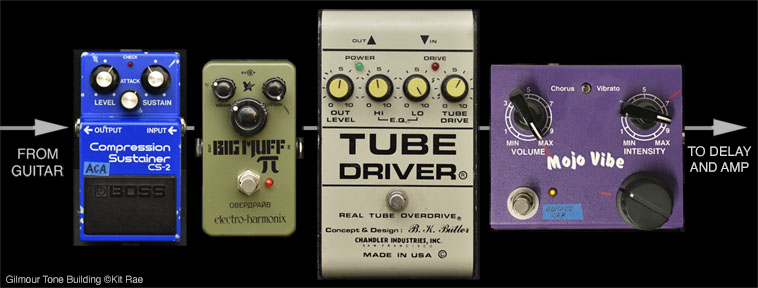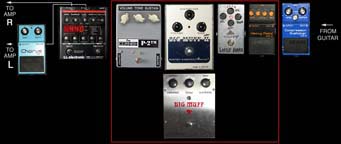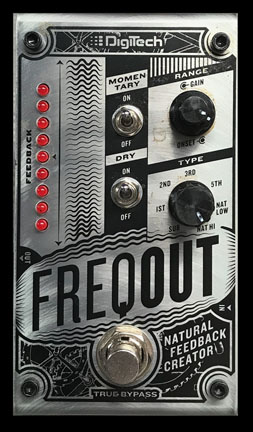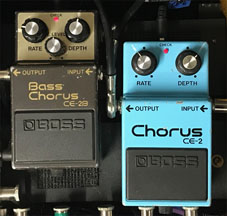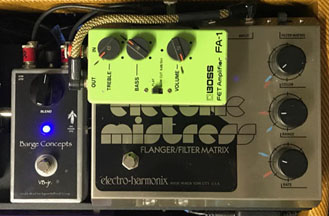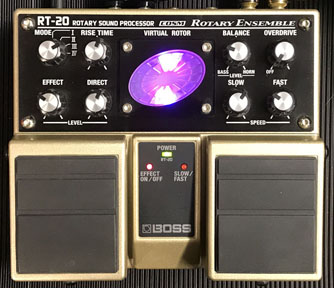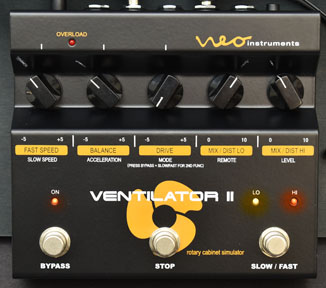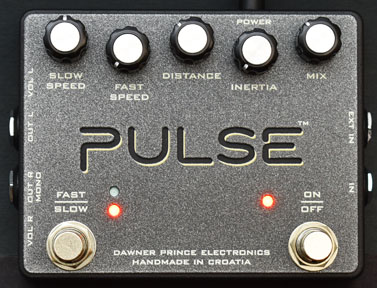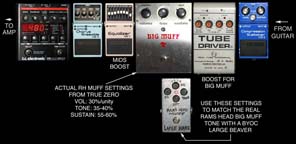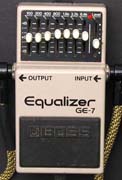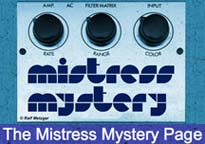NOTE: This website is frequently updated. Last update July 2023.
THE SOVTEK BIG MUFF - David needed a Big Muff for the older Pink Floyd songs he would be playing on the tour. Reportedly he tried out around 10 different models but ultimately he chose one of the newer Sovtek Big Muffs rather than one of the older USA made Electro-Harmonix models. It was the primary high gain distortion effect used on the tour. David used it again for his 2015-2016 solo tour.
The Electro-Harmonix brand had recently been resurrected and one of the first pedals brought back to the market around 1992 was the Big Muff Pi, under the brand Sovtek. They were Manufactured in St. Petersburg Russia. Rather than use one of the original Big Muff circuit designs, Sovtek revised it and gave it a slightly smoother tone with more mid range, and a fatter bottom end than the American made originals. Those early Sovtek Big Muffs were made in several different color schemes, but one particular version from around 1992 assumed the nickname "Civil War", for its blue and gray colors, reminiscent of the U.S. Civil War uniform colors. This version is numbered as 7A on my Big Muff Page website. Version 7B also used the same circuit, as did the first edition of version 7C, which is nicknamed the "tall font" green Russian.You can find out more information about the V7A here. The Sovtek line was discontinued in 2009 but in 2017 Electro-Harmonix reissued the "Green Russian" version of the Sovtek Big Muff and it is perfect for this sound. In 2018 they released the Sovtek Deluxe Big Muff which is also perfect for this sound, and much more versatile to make it sound great on a wide variety of amps, not just Hiwatts. I highly recommend both.
(left photo) The Sovtek Deluxe Big Muff next to and original Sovtek "Civil War" Big Muff like David used.
(right photo) A Green Russian Reissue next to an original Sovtek "Tall Font" Big Muff which uses the same circuit as the Civil War version.
Combined with a Tube Driver before it, and chorus/delay after, this Big Muff was the high gain "Pulse" distortion sound. Here is a selection of various Gilmour solos using the Sovtek Big Muff Pi from the Pulse CD and various 1994 audience recordings of the Division Bell tour. Clips in this order: Hey You, Sorrow, Time, Money, Comfortably Numb first solo, One of These Days, On the Turning Away, Comfortably Numb second solo, Sorrow outro solo.
![]() David Gilmour Sovtek Big Muff Pi Solo Selections
David Gilmour Sovtek Big Muff Pi Solo Selections
Below are my recommended Sovtek Civil War Big Muff settings when using a Hiwatt DR103/504 or similar amplifier. These also apply to the EHX Green Russian reissue and the EHX Sovtek Delux Big Muff. NOTE - the knob zero points on the original Sovteks varied randomly from knob to knob, and from unit to unit, so even though we have photos showing David's exact tick marks, they will be completely different on another Sovtek BMP. That said, I have owned one (out of six) examples of that exact Sovtek model, that DID have matching zero points for all three knobs. Based on David's 1994 and 2015/16 settings on this pedal, his is NOT one of those, so the settings I list are based on what I hear.
Volume: 1:30 / 65% (or adjust to unity in your rig)
Tone: 10:30 / 35% (bass left, treble right)
Sustain: 4:00 / 90% - 100%
TUBE DRIVERS - David used two original 1986-87 B.K. Butler/Chandler branded Tube Drivers. These have popularly become known as the "Pulse" Tube Drivers. The red knobbed one was labeled #1 and the other #2. Both appear to have had identical settings early in the tour. Settings from the end of the tour show that David set the DRIVE and LO knobs higher on his #2 Tube Driver, which I believe is what is heard on the Pulse album and concert video. Tube Driver #1 was used for light overdrive (thythm and apreggios) and blended with the Sovtek Big Muff, or the Rat, for the high gain solos. Tube Driver #2 was used for some of the heavier overdrive rhythm playing, for some lead solos, and blended with the Big Muff or P-2 for the Time solo.
There were several versions of these 1980s Tube Driver circuits that had minor differences. I suspect the circuits in both of David's Pulse TDs were the more common second version from 1987, but there is no way to know for sure. The later Real Tube and B.K. Butler 911 Tube Drivers can also be used for this sound. A common mistake people make is to set their 911 Tube Driver to David's exact 1994 settings and expect it to sound like his did, but 911 Tube Drivers do not have the exact same pots or circuit as the older 1980s Tube Drivers, so different settings are required. You can read more about David's Tube Drivers HERE. An article on the Tube Driver can be found HERE, and a list of the different versions of the Tube Driver can be found HERE.
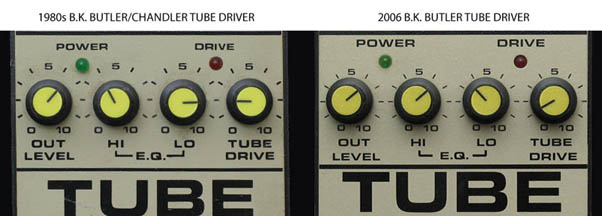
shown above - Gilmour's #1 B.K.B./Chandler Tube Driver settings from the 1994 Pink Floyd tour (left) and what similar settings would be on a B.K. Butler 911 Tube Driver (right).
shown above - These are David's revised #2 Tube Driver settings (left), and what similar settings would be on a 911 Tube Driver (right).
TUBE DRIVER BOOST BEFORE OR AFTER THE BIG MUFF? - On this tour David always boosted/blended a Tube Driver with his high gain distortions. Tube Driver #1 was placed before the Sovtek Big Muff, P-2, or Rat in the signal chain for the high gain solos. That Tube Driver + Big Muff combo was the one used the most. Tube Driver #2 was placed after the Big Muf or P-2 only for the Time solo.
RACK UNI-VIBE - David's backline tech, Phil Taylor, had a Uni-Vibe effect pedal into a custom rack enclosure for the effect rig. Below are David's typical settings, which are the same except for the Fast Speed knob position. The speed control was modified so that fixed slow and fast speeds could be selected via a footswitch on stage beside David's midi foot switcher. This effect was only used for a few Dark Side of the Moon songs.
shown above - Gilmour's Univibe settings used throughout the 1994 tour
HEIL TALK BOX - Gilmour used a borrowed Electro-Harmonix Golden Throat talk box for the album version of the song Keep Talking in 1993. A Talk Box is a device that allows you to make vocal-like changes to your guitar signal using a tube that is placed in your mouth while playing. The effect was first popularly used used in rock music by Joe Walsh in the song Rocky MountainWay in 1973, then later popularized by Peter Frampton and others. It has characteristics of a wah-wah pedal, but is much more expressive. David used a Talk Box in 1975 for an early demo of Welcome to the Machine that was never released, but his first official recorded use was for Pigs (Three Different ones) from the Animals album back in 1977.
shown above - Two versions of the Electro harmonix Golden Throat voice box, like Gilmour used on the studio recording
The 1994 tour was the first time David had used a talk box live. A new Heil Talk Box, made by Dunlop, was purchased and modified by Pete Cornish for use in David's rig. The speaker out jack of a Hiwatt AP100 connected to the Talk Box input. Inside the Talk Box enclosure is a speaker. A plastic tube is connected to a hole over the speaker, and the other end of the tube connects to the mic stand beside the vocal mic, where David would place his mouth over the tube. When he played the guitar, the sound vibrations from the speaker came out of the plastic tube in David's mouth. He could change the shape of the sound by changing the shape of his mouth, thus making his guitar have volcalized sounds. The sound from the tube was picked up by his vocal mic. Since David ran the Hiwatt used with the Talk Box quite loud, and the small speaker inside was mid range focused, a dummy load box was connected to the Hiwatt to absorb the low end signal.
The Heil has a tiny horn unit, and if you power it with a 100 Watt amp, there is nowhere for the bottom end signal to go and you quickly burn out the output transformers. So Pete (Cornish) introduced a crossover to remove those frequencies. - Phil Taylor, March 1997 Sound On Stage
The Heil is essentially an 8ohm speaker cabinet with a plastic tube connected to a sound hole in the top, but there have been other, more pedalboard-friendly versions of the talk box made that do not require a second amplifier to use the effect. The MXR M222 and Rocktron Banshee talk boxes both include built in amplifiers, so they can be run in a typical pedalboard.
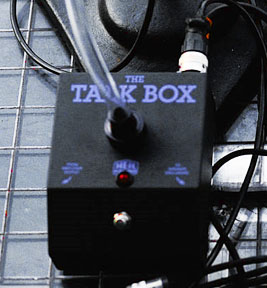
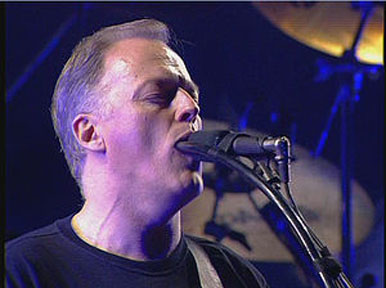
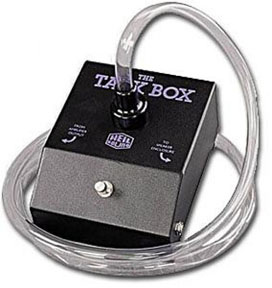
shown above - (left photo) Gilmour's Heil Talk Box and Gilmour using it in 1994
EQUALIZERS - David has used Boss GE-7 equalizers on his pedalboards since the 1980s to fine tune certain guitar tones. For his 1994 rig there were five GE-7s and each was modified by Pete Cornish to give a flatter EQ at the zero slider positions and to reduce noise. It's a minor difference, but this mod corrects the EQ range on the stock GE-7, which outputs a few decibels below the input signal.
One GE-7 was in a loop with the ProCo Rat, so it was always on when the Rat was used for the dry solo in Money. There was also a GE-7 built into David's Cornish Soft Sustain SS-2. The other three were set for specific for types of EQ - one for a Treble and Bass boost, one for a Treble/Bass boost and Mid cut, and one for a Mids boost. Each was in a separate effect loop and only used for specific parts of a few songs.
Grapic A - This bass boost was used to fatten the clean Shine on You Crazy Diamond intro, the intros to Sorrow and Time, and for the dry solo in Money with the Proco Rat.
Graphic B - The mids boost was only used for Syd's Theme and Great Gig in the Sky.
Graphic C - The Treble and Bass boost was used for one performance of the SOYCD intro, but I have never found any other instance where it was used.
shown above - Gilmour's GE-7 equalizers, modified by Pete Cornish
GETTING THE TONES - While I prefer the high gain lead guitar tones from the 1988 tour over the 1994 tour sound, there were still some exceptional Big Muff tones on this tour, and I love David's overdrive tones using the B.K. Butler Tube Driver and the Rat. First, let's get this out of the way. David's guitar sound on Pulse is mostly a studio mixing creation that was heavily EQ'd and altered. His guitar sound was very different in the actual concerts. Below is what it really sounded like versus Pulse. This sound clip compares a live soundboard recording from Rotterdam, September 4th 1994 (from a television promo) with the heavily remixed Pulse sound recorded in October.
![]() Comfortably Numb first solo - Rotterdam soundboard/tv promo (first) compared to Pulse (second)
Comfortably Numb first solo - Rotterdam soundboard/tv promo (first) compared to Pulse (second)
I prefer the actual live sound, but I am assuming that most people want to replicate the tones heard on the Pulse album, not the real Doppola-heavy tour sound. Below are the key elements needed to create most of those tones.
Building the Pulse tones is rather easy if you have a Hiwatt DR103/504, a Hiwatt replica like a Reeves or Hi-Tone, or a similar sounding amp, along with complimentary speakers. I mostly use a Reeves Custom 50 through a 2x12 speaker cab with a Reeves Vintage Purple and a Celestion G12T-75, or a Hi-Tone Eclipse cab loaded with Crescendos and G12T-75s. I have also used a Hiwatt DR103 and Fender 59' Bassman comboed with the Reeves or Hiwatt. Some amps, especially those that do not have much mid range, may be more difficult to achieve these tones and require the adition of an EQ pedal like a Boss GE-7 to boost the mids. For the guitar, a Strat with EMG-SA pickups is ideal, and the SPC control is part of the tone mix for this rig. However, any Strat with a hot bridge pickup and a fat, bluesy neck pickup will work, but there is definitely something unique about the SPC control in the EMG-SA set. David would crank it to 10 for the Big Muff solos.
Do You Need an Alembic F2-B Preamp for the Pulse tones? - David used the Alembic F2-B preamp instead of the Hiwatt preamps in his 1990 and 1994 rigs. One of the primary differences between the Hiwatt tone stack and the F2-B Fender tone stack is the F2-B uses a 10k mids pot and the Hiwatt uses a 100k, and is strictly mid range focused. David set his F2-B mids knob to maximum and had Pete Cornish modify it to give it more mid range on the top end, similar to the Hiwatt preamp. David also used a high treble setting and the minimum bass pot setting. A capacitor was changed to reduce the bass frequencies that caused David's sound to be too boomy through his four closed-back 4x12 speaker cabinets.
I had one channel of my F2-B modified by replacing one of the 10k mids pot with a 25k, which aded a significant boost to the mids frequences, and reduced the size of the cathode bypass cap to cut some of the low bass frequencies. I also had a buffered bypass loop added before my Hiwatt power amp to experiment using my F2-B as the Hiwatt preamp. The tone of the modifed F2-B channel was a bit too thin and harsh to my ears. If I dialed the mids lower and the bass higher it sounded better, but then it was not really any different than the unmodified channel. I was only running it into one amp and one 4x12 speaker cab though. David ran his F2-B into 2 Hiwatts powering four 4x12 speaker cabs, plus the Hiwatts that powered powered the Doppola speakers, so his tone was a mix of all those amps and cabs. Through my smaller rig, those mods proved unnecessary.
The tone of the unmodified channel of my F2-B was not much different than what I could get with the stock Hiwatt preamp to my ears. As mentioned previously, Pulse does not sound like what David's guitar really sounded like in 1994 concerts. The F2-B is perhaps a little closer to his actual live tour guitar sound, but not the sound I hear in the Pulse recordings. In other words, if you have a Hiwatt DR103/504 running into a 2x12 or single 4x12 cab, in my opinion, you do not really need an F2-B to recreate the Pulse tones. Using the right speakers has much more affect on those tones.
For pedals, you need the following:
1. Big Muff - I use a 1990s era Sovtek Big Muff or the EHX Green Russian Reissue. The EHX Sovtek Deluxe Big Muff is also a good one, but I highly recommend the EHX Green Russian Reissue. There are also many Green Russian/Civil War Big Muff clones, and there are many other types of Big Muff that also work, depending on what type of mid range your amplifier has.
2. Tube Driver - I use B.K. Butler/Chandler Tube Drivers and Butler 911 Tube Drivers. There are also various similar tube drive pedals that Butler designed. A modern BK Butler 911 Tube Driver or older 4-knob Tube Works 911 Tube Driver would are ideal, but there are others that work like the US made Tube Works Real Tube. There are also a few similar sounding pedals, like the Boss Blues Driver or Buffalo TD-X. The Tube Driver is used to blend with the Big Muff tone, compressing and EQ'ing it so it has a more warmth and bite.
3. Boss CE-2 Chorus - I use a CE-2 chorus and a Boss CE-2B, which has the perfect mid range boost for the Pulse tones. The CE-2B has a built in effect level knob to dial in the desired amount of chorus effect. It can even be modified to CE-2 specs as there is only one capacitor that is different.
The CE-2 use in this rig was oftern misunderstood. If you look at the song-by-song signal chains, most of the time David used a chorus only in the left channel of his two-amp stereo rig, so it was not very dominant. It was mostly used to enhance the stereo field between the amps. For a mono rig with only one amplifier, that means you only need 50% of the chorused signal blended in with your clean signal to sound accurate. An effect level knob like on the CE-2B allows you to do this, or you can use a blend pedal with the mix dialed back 50%. There are many other chorus pedals that also work, like a Boss CE-2W, but any with a blend or effect level knob will work best.
David did use a second CE-2 in both channels for a much more dominant chorus, but it was only used for a few songs - Breathe Reprise , the Syd's Theme section of Shine On, the intro to Another Brick II and the solo, the Time intro, Run Like Hell, and occasionally in the Comfortably Numb solos.
4. Digital Delay - I use a TC Nova delay or FTT Future Factory delay, but there are numerous good digital delay pedals out there. One with a display that shows the time in miliseconds is preferable. Delay times for most songs can be found HERE.
5. Boss CS-2 Compressor - I mostly use a Boss CS-2, but there are many others that will work, like the MXR Dynacomp. This is used to compress the clean tones and light overdrive tones, increasing the volume and sustain of the light picking and reducing the volume of the heavy picking while compressing and adding sustain. You can also use it in front of the Big Muff instead of a Tube Driver to add some punch to your pick attack and enhance the string harmonics.
__________________________________________________________
Signal chain for David's clean tones: Boss CS-2 Compressor > Digital Delay > Boss CE-2
Signal chain for David's overdrive tones: Boss CS-2 Compressor > Tube Driver (medium drive settings) > Digital Delay > Boss CE-2 chorus
Signal chain for David's high gain lead tones: Boss CS-2 Compressor > Tube Driver (light drive setting) > Sovtek Big Muff > Digital Delay > Boss CE-2 chorus
__________________________________________________________
Pulse Clean Tone - David had a beautiful clean lead tone for this tour. It was basically a Strat tone with compression, delay, and a little bit of chorus. The intro to Coming Back to Life was one of the stand out songs from this tour using that tone. The basic tone is rather simple to achieve, but the large hall reverb from the venues it was performed in, and in the Pulse recording, is a bit tricky to replicate. Pulse was also heavily EQ'd and altered in the mixing stage. Here is the Pulse audio isolated, and what David actually sounded like from an audience recording of that same performance.
Coming Back to Life Intro - Pulse mix from Earls Court, October 20th, 1994
Coming Back to Life Intro - Audience recording from Earls Court, October 20th, 1994
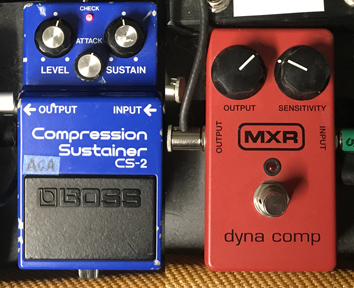
For compression, I use the Boss CS-2 and Dynacomp, using David's exact settings. You can also use a single compressor to achieve the same effect. For the chorus, I use a Boss CE2-B or CE-2. The long 630ms delay is also a large part of the tone. For reverb, I have tested various digital reverb pedals with spring, plate, room, and hall reverb. The best effect to achieve the big reverb sound of Pulse is plate reverb in my opinion, but below are some examples.
Coming Back to Life Intro - Basic Tone without reverb - Boss CE-2 > MXR Dynacomp > Boss CE-2B with mix at 30% (both channels) > Future Factory 630ms delay > Reeves Custom 50. Strat with EMG-SA neck pickup. SPC off.
Coming Back to Life Intro with Room Reverb - using a Free the Tone Ambi Space digital reverb. This sounds good, but not accurate to my ears.
Coming Back to Life Intro with Hall Reverb - using a Free the Tone Ambi Space digital reverb. This type of reverb sounds too distant compared to Pulse
Coming Back to Life Intro with Plate Reverb - using a Free the Tone Ambi Space digital reverb. This is the best simulation of the Pulse concert hall sound to my ears.
Below is a clip with the same plate reverb settings as above, but using the stereo outs from the Ambi Space into a Reeves Custom 50 in the left channel and 59 Bassman in the right. I turn each effect on one at a time so you can hear what they add to the tone.
Coming Back to Life Intro Tone Build
Effects switched on in this order:
Boss CS-2 + Dyncomp
Boss CE-2B chorus in left channel
Future Factory delay
Ambi Space plate reverb
Coming Back to Life Intro with Two amps in Stereo - Same settings and amps as above, but I added a room microphone in addition of the speaker cabinet microphones. It really opens up the space and gives it more of the concert hall sound.
__________________________________________________________
High Gain Lead Tones - The setup for most of the high gain lead tones is rather simple. A Butler Tube Driver running into a Sovtek Big Muff was basically the core sound, with chorus and delay. The Tube driver slightly EQs and fattens the tone before it hits the Big Muff, creating a blend of the two sounds. The remixed and heavily EQ'd version of David's lead tones on Pulse sounded quite different than what he actually sounded like in concert. For reference, here is an audience recording of of Comfortably Numb, the exact same performance used for Pulse.
Comfortably Numb outro solo - audience recording from Earls Court, October 20th, 1994
In the clip below I switch each effect on one at a time so you can hear what each contributes to the tone as it is added. I am using a Strat with EMG-SA pickups and the SPC control set to maximum. The amps used are Left Channel = Reeves Custom 50 into a Hi-Tone Eclipse cab and Right Channel = Fender 59 Bassman.
1994 High Gain Lead Tone Building
Effects switched on in this order:
Clean Tone
EHX Green Russian Big Muff
BK Butler Tube Driver
Boss CE-2 chorus (both channels)
second Boss CE-2 chorus (left channel)
Future Factory delay
Ambi Space plate reverb
Below is a more simplified signal chain for the Comfortably Numb outro solo, just to show you do not need all of that gear to get the basic tone. In this clip I use a Boss CS-2 compressor, EHX Green Russian Big Muff, Boss CE-2-B chorus, and a digital delay. Strat with regular single coil pickups into a Fender 59 Bassman.
1994 Simple High Gain Lead Tone Building
Effects switched on in this order:
Clean Tone
Green Russian Big Muff
CS-2 Compressor
Boss CE-2B chorus (mix knob at 50%)
Future Factory delay(540ms)
Below is a sound clip demonstrating the difference between the Big Muff and Tube Driver +Big Muff. The Big Muff is first, the Tube Driver/Big Muff combo second.
As you can hear, you do not really need a Tube Driver to get a good Pulse Big Muff tone, but it is more accurate. Below are Tube Driver + Big Muff sound clips demonstrating the difference between a Tube Driver placed before a Big Muff and Tube Driver after a Big Muff in the signal chain. The TD and Muff settings were identical in each clip. The TD after the muff sounds more overdriven and on the edge of breakup than the one before, but the settings on each pedal can be changed to sound like the opposite.
Below is a clip of One of These Days, demonstrating the basic 1994 Tube Driver/Big Muff lead tone with all of the effects in the signal chain, including a Boss chorus in both channels and a second Boss chorus in left channel. The left chorus slightly widens the stereo field and boosts the overall midrange. This clip also uses a different amplifier in each channel, mimicking the style of the stereo rig David used.
One of These Days - Strat with EMG-SA pickups, SPC at maximum. BK Butler Tube Driver > EHX Green Russian Big Muff > Boss CE-2 > Future Factory Delay > Ambi Space reverb > Boss CE-2 (left channel only). Left Channel = Reeves Custom 50 into a Hi-Tone Eclipse cab. Right Channel = Fender 59 Bassman.
Below is a clip of the first Sorrow solo, demonstrating the basic lead tone with a single chorus in both channels.
Sorrow First Solo - Strat with EMG-SA pickups, SPC at maximum. Boss CS-2 > BK Butler Tube Driver > EHX Green Russian Big Muff > Boss CE-2 > Future Factory Delay > Ambi Space reverb > Reeves Custom 50 into a Hi-Tone Eclipse cab.
Below is a clip of the Sorrow intro using a Strat with EMG-SA pickups, an Alembic F2-B preamp with the mid range set to maximum, going into a Reeves Custom 50 (Hiwatt clone).
Sorrow Intro - Strat with EMG-SA pickups, SPC at maximum > B.K Butler Tube Driver > Sovtek Big Muff > Boss CE-2 chorus > TC Nova delay set for 540ms > Alembic F2-B into Reeves Custom 50
Sorrow Intro - same as above but without the backing track
David added a Uni-Vibe effect to his Time guitar solo for this tour. It was the only guitar solo on the tour that had the Tube Driver after the Big Muff in the signal chain. This was probably to drive the signal harder into the vibe, which helps make the throbbing phase shifting moduation of the Uni-Vibe more prominent. The clip below uses David's same signal chain and effect settings, but I added a Boss CS-2 compressor in front to even out the signal more. I am using a Mojo Tono Mojo Vibe, which is a high quality replica of the Uni-Vibe circuit.
Time solo - Strat with EMG_SA pickups, SPC at 5 > Boss CS-2 > Sovtek Big Muff > B.K Butler Tube Driver > Mojo Vibe > Future Factory Delay (540ms) > Ambi Space plate reverb > Reeves Custom 50 (R) and 59 Bassman with Boss CE-2 chorus (L)
The clip below is the same setup, but without the Tube Driver. The distortion is slightly less overdriven, but not that different than with the TD.
Time solo - Strat with EMG_SA pickups, SPC at 5 > Boss CS-2 > Sovtek Big Muff > Mojo Vibe > Future Factory Delay (540ms) > Ambi Space plate reverb > Reeves Custom 50 (R) and 59 Bassman with Boss CE-2 chorus (L)
The Uni-vibe tone reminds me of the Robin Trower song Bridge of Sighs. It also used a heavy vibe effect in a similar manner, which is easily replicated with just a Tube Driver.
Bridge of Sighs - Strat > Boss CS-2 compressor >B.K Butler Tube Driver > Mojo Vibe > Future Factory delay > Ambi Space plate reverb > Reeves Custom 50
There are many other types of Big Muff that you can use to get similar Pulse lead tones without blending with a Tube Driver. This clip is the Time solo played with an EHX Triangle Big Muff, which is a bit more aggressive than the Sovtek Big Muff sound. David used a vibe effect for this solo on the tour, but I do not in this clip. The setup is simple, just three pedals: Big Muff > Boss CE-2 > TC Nova delay > Reeves Custom 50 into 2x12 Reeves speaker cab with Weber FC12 speakers. Strat with Seymour Duncan SSL-5 bridge pickup.
There are many types of fuzz pedals you can use for the high gain leads without blending with a Tube Driver. Below is the first solo from Sorrow played on a range of pedals, for reference. All are played on a a Strat with a Seymour Duncan SSL-5 bridge pickup. The setup is very simple, just four pedals: Boss CS-2 compressor > Distortion > TC Nova Delay at 440ms in stereo > Boss CE-2 chorus in left channel of the Nova. The Compressor is used to compress and add more attack to the distortion, which really helps with the pinch harmonics in the playing.
![]() Sorrow Solo - Civil War Big Muff ............
Sorrow Solo - Civil War Big Muff ............![]() Sorrow Solo - Cornish P-2 ...........
Sorrow Solo - Cornish P-2 ...........![]() Sorrow Solo - Ram's Head Big Muff ............
Sorrow Solo - Ram's Head Big Muff ............![]() Sorrow Solo - BYOC Large Beaver ............
Sorrow Solo - BYOC Large Beaver ............
![]() Sorrow Solo - BK Butler Tube Driver ............
Sorrow Solo - BK Butler Tube Driver ............![]() Sorrow Solo - Boss HM-2 ..
Sorrow Solo - Boss HM-2 ..
The setup for most of the overdrive solos was essentially a compressor, Tube Driver, chorus, and delay. Below is an example of David's basic overdrive tone.
Coming Back to Life Solos - Strat with EMG-SA pickups, SPC at 5. Boss CS-2 compressor > BKB/Chandler Tube Driver > Boss CE-2 chorus > TC Nova delay > Reeves Custom 50. First solo with EMG-SA neck+middle pickup. Second with neck pickup.
__________________________________________________________
Feedback in Sorrow - Most fans of this and the Delicate Sound of Thunder period of Gilmour guitar tones would probably point to the live version of Sorrow as one of their favorites. Unfortunately it is very difficult to achieve the trademark feeback sound for the intro and outro of the song at low amp volumes. Even at high volume it can be a bit tricky to get the feeback when you want it, unless you are using a Hiwatt and a 4x12 speaker cabinet. One way around that is the Digitech Frequot. HERE is an article on how it works.
__________________________________________________________
DOPPOLAS /ROTARY SPEAKERS - I have not yet mentioned replicating the Doppola rotary speaker sound because in the Pulse mix that most Pink Floyd fans are familiar with, the Doppolas are barely even there. They were very prominent in the live concerts I attended and on most of the audience recordings I have heard, but they were mixed quite low in the September and October 1994 Earl's Court concerts recorded for both the Pulse album and concert video, and the original October 20th 1994 video broadcast. Below is a comparison of the Earl's Court Pulse sound to the typical live sound from 1994. The Boss CE-2 chorus in the left channel is probably the more dominant modulation in most of Pulse, but in the live concerts it was the Doppolas.
That warbly, swishing/sawing sound you hear in the Torino and Bordeaux clips is the doppler effect of the Doppola speakers rotating. On Pulse, you really only hear Doppolas prominently in parts of a few songs, like the intro and outro of Sorrow. The rest of the time the Doppolas are mixed so low they just seem to be creating an enhanced chorus sound and widening the stereo field.
The most accurate way to create heavy live Doppola sound is with rotary speaker cabinets, but that is an expensive option, and proper rotary speaker cabinets are not easy to find. A Leslie speaker cabinet sort of works, but it is really a different type of rotary sound since it features a rotary horn for highs, and a rotating bass baffle for the lows, not actual rotating speakers. Real rotating speaker cabinets like the Yamaha RA-100 or RA-200 can create a simlar sound as the Doppolas, but those are rare and expensive. There have been a few Doppola replicas made, but they are also rare and expensive.
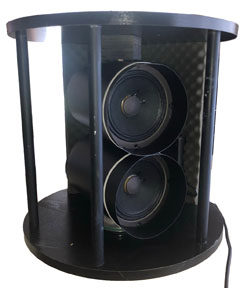
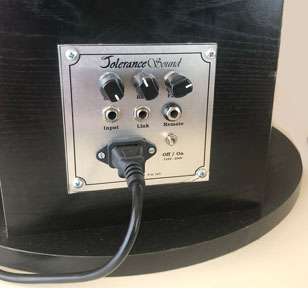
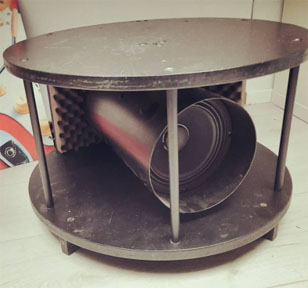
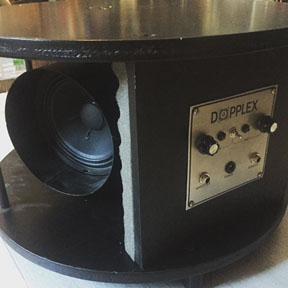
(left) Tolerance Sound Revolver and (right) Taurus Electronic Designs DoppleX
Two Doppola replicas I know of are the Tolerance Sound Revolver (built in Spain in 2009, now discontinued) and the Taurus Electronic Design DoppleX (built in 2020). There were two versions of the Revolver, which featured Mercury connector contacts for the revolving speakers and 100w speakers, similar to David's originals. The P16 model had a single 6" speaker and the P26 had two 6" speakers. Similarly, the DoppleX DX16 model had a single 6" 100w speaker and the DX26 model had two. Both of these are simply speaker cabinets, so they have to be fed a signal from an amplifier just like any other speaker cabinet. There is no built in amplification. Although a single rotating speaker sounds good when combined with the sound from another amplifier and normal speaker cabinet, you really need two sets of rotary speakers, each running at different speeds, to replicate David's out-of-sync Doppola sound, which usually had an always changing doppola effect.
For most people, a better option for either the heavy live rotary sound, or the lighter Pulse rotary sound, is a chorus or rotary pedal. In a two-amp stereo setup you can achieve a similar effect as Pulse with a CE-2 or CE-2W chorus in front of each amp, last in the signal chain, or with a CE-2/CE-2W going to both amps, and a second CE-2 going to only one of the amps. In a single-amp mono setup you can achieve a similar effect with by using a Dawner Prince Pulse or a Boss CE-2 or CE-2W combined with a second CE-2 running through a blend pedal to reduce it in the mix to 50%. Or use a Boss CE-2B, which already has a blend knob built in. Another option is a CE-2/CE-2W combined with an Electric Mistress running through a blend pedal at 50% mix. Just using a CE-2 or CE-2W by itself works really well also.
(left) Boss CE-2B and Boss CE-2 settings replicate the Doppola sound in a mono rig. An Electric Mistress through a blend pedal can also be used instead of a CE-2B (right)
If you want something similar to the heavy Doppola sound heard in the 1994 tour soundboard and audience recordings, you really need to have a stereo rotary pedal with a blend knob, treble/bass (high/low) balance knob, and use it in a two-amp stereo rig. A mono rig works too, but the effect is much more accurate when you hear it in stereo. The Doppolas David used created a rotary speaker sound like the Maestro Rover and Yamaha RA-200, which have actual rotating speaker drivers inside. Unfortunately, most rotary pedals simulate a Leslie, which has a rotating drum baffle over a stationary bass speaker, and rotating horns over a stationary treble speaker. Leslies create a beautiful, warbly doppler effect, but it is a different type of sound than actual rotating speakers like the Rover, RA-200, and Doppolas.
Settings to replicate the stereo Doppola effect heard on the 1994 tour for the Boss RT-20 Rotary Ensemble, Neo Ventilator II, and Dawner Prince Pulse
A necessary control for a rotary pedal to work for Gilmour's rotary speaker tones tones is a blend knob to allow the dry signal to blended with the effect signal. A balance control to adjust the amount of LO bass speaker signal vs the HI horn signal, and a mic distance control, are also important features. There are several rotary Leslie type pedals that have those necessary controls. The closest for this purpose that I have used are the Boss RT-20 Rotary Ensemble and the Neo Instruments Ventilator II. They are not quite the same as the Doppola sound and both are slightly noisy (hiss), but they work very well. I dial the balance knob on each so the bass (LO) speaker sim is high in the mix and the horn speaker (HI) sim is low (there was no horn in the Doppola speaker cabinets). The RT-20 has an effect level mix knob to allow you to dial in the desired amount of rotary sound to mix in with your dry signal. The Ventilator II has mix knobs for both the LO and HI speakers to do the same thing. The Dawner Prince Pulse also has the necessary controls for this effect and sounds exceptionally good. However, instead of two rotor sounds running simultaneously like the Vent and RT-20, the Pulse only has a single rotor, so the sound is not as rich and complex.
Using the mix knob, I usually blend the effect in around 35-40% for the 1994 tour sound, and 20-25% for the Pulse live album sound. It is also important to set the rotary speed correctly. Nearly all of the emulator pedals have a fast/slow speed selector and speed controls. Select the slow speed for just about everything except Any Colour You Like. The slow speed settings I use equate to about 90 - 120 rotations per minute (rpm). I have found those speeds sound best. Lower rpm for slower tempo songs and faster rpm for faster tempos.You can determine the rotation speed on a rotary emulator by counting how many rise peaks, or rotations, you hear over a full minute. The RT-20 has LEDs that visually rotate, so that helps.
David tended to use slow Doppola speed settings for just about everything. The only clear example of rotor speed from The Division Bell album is the Wearing The Inside Out solo. There is a video of David recording the solo in his Astoria recording studio where the Rover can be seen to be rotating about 85 rpm, or about 1.4 rotations per second, which is very slow. For the 1994 tour the Doppolas in the left and right channels were each running at different speeds, but the rise peak of each rotation of the dominant Doppola can sometimes be heard in the soundboard and audience recordings. I timed the Sorrow intro and outro and What Do You Want from Me to be about about 119 rpm. The Sorrow and Comfortably Numb solos were about 128 rpm. I timed SOYCD to about 112 rpm. Sometimes it was difficult to determine a specific rotor speed because both left and right Doppolas were equally balanced. I can clearly hear two different speeds in some of the the On the Turning Away solos, especially the Torino soundboard recording. I think it is 128 in the right channel and 119 in the left, but the rise peak when the two doppler waves cross over may be skewing the rpms I hear.
Below are a few stereo RT-20 sound clips replicating David's slightly dirty overdrive tone using an EMG Strat and a Tube Driver through a Reeves Custom 50 through a Hi-Tone Eclipse speaker cab (left) and Fender 59 Bassman (right). The RT-20 is last in the signal chain. The stereo delay is set for 500ms and 375ms.
Shine on You Crazy Diamond/Syd's Theme with Boss RT-20
Syd's Theme Tone Build
Effects switch on in this order:
Boss CS-2 compressor
Boss CE-2 chorus
Boss RT-20 Rotary Ensemble
FTT Future Factory stereo delay
BKB/Chandler Tube Driver (at 33 second mark)
As you can hear, the RT-20/CE-2 combo works very well when using clean or slightly overdriven tones. It also works for the arpeggios from Us and Them and the fast Leslie sound from Any Colour You Like. Below are stereo sound clips for David's high gain lead sound, using an EMG Strat, Tube Driver, EHX Green Russian Big Muff, Boss CE-2, and Boss RT-20 last in the signal chain, through a Reeves Custom 50 (left) and Fender 59 Bassman (right).
Sorrow intro with Boss CE-2 and RT-20
Sorrow intro with EXH Green Russian only, for comparison - no Tube Driver, CE-2 or RT-20, just the raw Russian Big Muff sound
Sorrow first solo with Boss CE-2 and RT-20 in stereo mode (Reeves Custom 50 and 59 Bassman amps)
Sorrow first solo with Boss CE-2 and RT-20 in mono mode (Reeves amp only)
Sorrow first solo with Boss CE-2 and RT-20 in stereo mode - no backing track
Sorrow first solo from the Torino Italy soundboard recording from Sept 1991, then from the Earl's Court radio boadcast from Oct 1994 - for comparison
On the Turning Away with Boss RT-20 only
On the Turning Away with Boss CE-2 and RT-20
On the Turning Away solo from Chantilly, France, July 1994 - for comparison
As you can hear, the RT-20 on its own is not completely accurate to the Doppola sound. Adding the CE-2 chorus enhances the sound, but also makes it slightly metallic sounding. The RT-20/CE-2 combo still works well for most of the high gain Big Muff solos
Below is an example of Run Like Hell with the Boss RT-20. This clip uses two delays in series. First is 380ms and the second is 245ms to create a slight ADT sound to the main delay. I think David actually used the 80ms ADT delay feature of the TC2290 delay for that doublt-track effcct, but either way, it helps thicken the tone. Boss CE-2 compressor, BKB/Chandler Tube Driver, Boss CE-2 chorus, FTT Future Factory stereo dual delay, Boss RT-20 Rotary Ensemble, into a Reeves Custom 50 (L) and Fender 59 Bassman (R).
Below are sound clips illustrating the differences between the Boss RT-20, Neo Ventilator II, and the Dawner Prince Pulse rotary speaker pedals. EMG Strat, Tube Driver, EHX Green Russian Big Muff, and rotary pedal last in the signal chain. Reeves Custom 50 with a Boss CE-2 chorus (left) and Fender 59 Bassman (right).
On the Turning Away with Boss RT-20
The RT-20 and Ventilator are very similar, but the Vent has a more Leslie-like sound. Both have a richer and more detailed sound than the Dawner Prince Pulse. That is due to the single rotor in the Pulse, but as long as it is not set too high in the mix, it sounds very good. It is also very transparent sounding and works better than the RT-20 and Vent for very lightly mixed rotary sounds. I think the RT-20 and Vent sound best for the heavy rotary sounds. The RT-20 is probably the most accurate to the '94 tour sound, but I think the Vent has a nicer, more liquid sound at higher settings, as you can hear in this clip.
On the Turning Away with Neo Ventilator II - heavy rotary sound
Below are some older setups and sound clips from the original version of this page.
TONE BUILDING WITH EMG SA ACTIVE PICKUPS - Here are some basic late 1980s through mid 1990s Gilmour tones using some of the same pedals and pickups David used. Fender Deluxe Stratocaster with EMG DG-20 SA active pickups, exactly the same pickups used in David's red strats from the mid 1980s through the 1990s. Used on the Momentary Lapse of Reason and Division Bell tours, as captured on the Delicate Sound of Thunder and Pulse CDs. All clips are played with a Fender Stratocaster through a clean, loud Fender Twin Reverb. There is an article and sound clips illustrating the difference between EMG SA pickup and vintage style Strat pickups HERE.
Pedals used, listed in chain order - Guitar > Boss CS-2 compressor > B.K. Butler Tube Driver > Red Army Overdrive (early Sovtek Big Muff, same as Civil War Muff) or V2 Ram's Head Big Muff > Boss GE-7 equalizer > Boss CE-2 or CE-5 chorus > TC Electronic Nova delay > Amp
![]() Tone Build Example #3 - Same as above, but playing Pink Floyd's On the Turning Away solo.
Tone Build Example #3 - Same as above, but playing Pink Floyd's On the Turning Away solo.
![]() Tone Build Example #5 - EMG DG-20 bridge pickup with pedal settings shown above. Playing Pink Floyd's Comfortably Numb solo. GE-7 set for treble and bass boost. I turn each pedal on in sequence to hear what each contributes to the tone.
Tone Build Example #5 - EMG DG-20 bridge pickup with pedal settings shown above. Playing Pink Floyd's Comfortably Numb solo. GE-7 set for treble and bass boost. I turn each pedal on in sequence to hear what each contributes to the tone.
SORROW INTRO TONE - The intro to Sorrow is one of my favorite tones. I Prefer the live versions of Sorrow from Delicate sound of Thunder and Pulse to the studio version. The intro tone is monstrous and alive with feedback. An integral component to the unique feedback sound is the EMG DG-20 bridge pickup with the SPC control on 10, but single coil pickups can also be used. The tone is definitely generated by a Big Muff with the sustain full on. David had a Ram's Head Big Muff, a Civil War Russian Big Muff, and a Pete Cornish P-2 Muff on his boards for these tours. The Delicate sound of Thunder version is the Ram's Head Big Muff and I believe the Pulse version is the P-2 because it has more gain than a Civil War Muff, though the Civil War Big Muff patch on David's pedalboard can be seen on is some of the filmed performances of this song. There is also a Boss CE-2 chorus being used, a long delay, a Tube Driver set to boost the Muff, and a compressor being used to increase the gain and sustain. The sustained feedback is enhanced and fed by David's very loud tube amplifier. It is tricky to get just the right feedback to make this sound work, but the key is to load the gain and sustain with a compressor or Tube Driver to drive the Muff and, most importantly, amp VOLUME. Too much feedback and you have an overloaded mess, and too little you have to wait for the feedback. I have found the guitar needs to be a certain distance from my amp to get the feedback to come when I need it, and standing with the guitar in relation to the amp in different ways produces different types of feedback. You will find the Muff with sustain maxed will be very noisy with both a Tube Driver and a compressor running, but you won't hear the noise it when playing, and the notes are almost constant with few quiet parts.
![]() Sorrow Tone Build - EMG DG20 bridge pickup with pedal settings shown above. GE-7 set for treble and bass boost. I turn each pedal on in sequence to hear what each contributes to the tone. This one needs to be loud to get the feedback, and I turn the SPC control on my EMG strat wide open
Sorrow Tone Build - EMG DG20 bridge pickup with pedal settings shown above. GE-7 set for treble and bass boost. I turn each pedal on in sequence to hear what each contributes to the tone. This one needs to be loud to get the feedback, and I turn the SPC control on my EMG strat wide open
DAVID'S SPC and EXG SETTINGS - See this page for for photos and settings from various songs for David's EMG controls, specifically the SPC control on his EMG fitted Strats.
PULSE TONE DEMOS BY FRÉDÉRIC PEYNET - Here are some excellent Pulse tone examples using an EMG Strat and a Koch Studiotone amplifier by Frédérick Peynet (Deck from the Gilmour Gear Forum). Frédérick is among the best at capturing these tones with his gear and playing.
Gear used and EMG settings
What Do You Want from Me : EMG Stratocaster > Demeter Compulator > Cornish G-2 > Boss CE-2 > T-Rex Replica > Koch Studiotone amp. EXG-2 SPC-6 Neck pickup
On the Turning Away: EMG Stratocaster > Demeter Compulator > Cornish P-2 > Tube Driver > CE-2 > Replica > Koch Studiotone amp. EXG-2 SPC-6-7 Bridge pickup
Poles Apart: EMG Stratocaster > Demeter Compulator > Cornish SS-2 > CE-2 - Replica > Koch Studiotone amp. EXG-5 SPC-10 Neck pickup
Sorrow: EMG Stratocaster > Cornish P-2 > Cornish SS-2 > CE-2 > Replica > Koch Studiotone amp. EXG-2-3 SPC-10 Bridge pickup
PULSE BIG MUFF COMPARISONS - David used three Big Muffs in his Division Bell rig - the "Ram's Head" Big Muff, Pete Cornish P-2 Muff, and "Civil War" Sovtek Big Muff. The Ram's Head has a deep, dark tone with the mids "scooped" out. It has a wilder, more out of control feel, and a huge thundery sound. The P-2 is a more refined Big Muff with added mids (less scooped), and more controlled, uniform, and smooth tone, yet still retains the high gain of the Ram's Head. The Civil War Big Muff has a very smooth tone with slightly less gain than the other two, and more bottom end. Below are comparison clips using a Strat fitted with EMG DG-20 pickups (EXG off, and SPC on 5) and a Fender Twin Reverb.
![]() Muff Comparison Clip - In this order: Ram's Head Big Muff, P-2, Civil War Muff ...........
Muff Comparison Clip - In this order: Ram's Head Big Muff, P-2, Civil War Muff ...........![]() Comparison Clip - Leads. In this order: Ram's Head Big Muff and P-2 playing leads.
Comparison Clip - Leads. In this order: Ram's Head Big Muff and P-2 playing leads.
![]() Comparison Clip - Chords/Rhythm. In this order: Ram's Head Big Muff and P-2 playing rhythm/chords.
Comparison Clip - Chords/Rhythm. In this order: Ram's Head Big Muff and P-2 playing rhythm/chords.
TONE BUILDING WITH VINTAGE STYLE SINGLE COIL PICKUPS - When I use vintage style pickups I can get a very similar sound to the SPC control in the EMG SA active pickups in David's red strats used on the Momentary Lapse of Reason and Division Bell tours by adding a Boss GE-7 equalizer set for a slight mids boost. Depending on how the mids are voiced in your amp and the mids in the pedals used, you may want to add a mid boost to create this tone, or in some cases it is better to remove some of the mids from the tone and bring up the bottom end with an EQ.
MIDS BOOST - Below is a typical mid boost setting on the BOSS GE-7 to mimic the mid boost sound David used in the mid to late 1980's and early 1990's, when he used EMG SA pickups with the SPC control set at about 50%.
MIDS CUT - In this example I am actually cutting the mids back to get a darker tone. Clips with Fender American Std Stratocaster with Seymour Duncan SSL-5 bridge pickup, which is a replica of the custom wound SSL-1 pickup in David's Black Strat. All clips are played with a Fender Stratocaster through a clean, loud Fender Twin Reverb.
Pedals used, listed in chain order - Guitar > Boss CS-2 compressor > Red Army Overdrive (early Sovtek Big Muff, same as Civil War Muff) > B.K. Butler Tube Driver > Boss GE-7 equalizer (pictured with mids scooped rather than boosted) > Boss CE-2 chorus > TC Electronic Nova delay > Amp
Kit’s Secret Guitar, Gear, and Music Page
Guitar stuff, gear stuff, soundclips, videos, Gilmour/Pink Floyd stuff, photos and other goodies.
Copyright Kit Rae.
VISIT MY SWORDS, KNIVES and FANTASY ART WEBSITE www.kitrae.net

